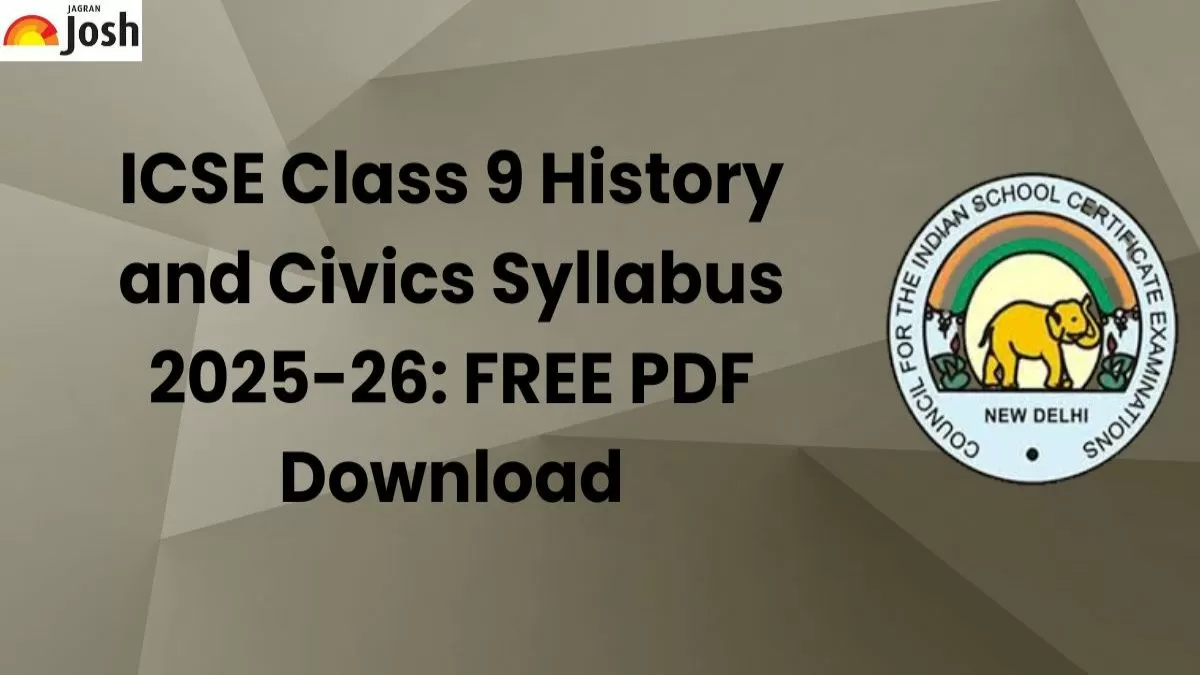ICSE Class 9 History and Civics Syllabus 2025-26: The ICSE board has released the revised syllabus for the academic year 2025-26. Students can check the syllabus here and download the PDF for free. It is important to have the revised syllabus to know about the important topics and the allotment of marks. This new syllabus will be followed for the 2025 board exams, and thus, students must refer to the latest edition to avoid any confusion. The ICSE Class 9 syllabus 2025 comprises the syllabus for compulsory and optional subjects. History and Civics are one of the subjects that students have in Class 9. The latest syllabus for this subject is provided here in PDF format. Check and download the PDF for better understanding.
ICSE Class 9th History and Civics Syllabus 2025-26: Aims
- To provide an understanding of the working of the Indian government necessary for the students to grow into responsible, enlightened citizens in a secular democracy.
- To enrich the understanding of those aspects of Indian historical development which are crucial to the understanding of contemporary India.
- To awaken a desirable understanding in pupils of the various streams which have contributed to the development and growth of the Indian nation and its civilisation and culture.
- To develop a world historical perspective of the contributions made by various cultures to the total heritage of mankind.
ICSE Class 9 History and Civics Syllabus 2024-25
There will be one paper of two hours duration carrying 80 marks and an Internal Assessment of 20 marks.
| SECTION A: CIVICS An elementary study is required of this section without verbatim study of the Constitutional Articles in detail. |
| 1. Our Constitution Definition of Constitution - date of adoption, date of enforcement and its significance. Features: Single Citizenship, Universal Adult Franchise, Fundamental Rights and Fundamental Duties, Directive Principles of State Policy (meaning), Welfare State. 2. Elections Meaning; Composition of Election Commission (in brief); Direct and Indirect election; General election; Mid-term election and By-election. 3. Local Self Government (i) Rural: Three-tier system of Panchayati Raj – Gram Panchayat, Panchayat Samiti, Zila Parishad – their meaning and functions. (ii) Urban: Municipal Committees and Municipal Corporations – meaning and functions. |
| SECTION B: HISTORY |
| 1. The Harappan Civilisation Sources: Great Bath, Citadel, seals, bearded man, dancing girl, dockyard, script. Origin, extent, urban planning, trade, art & craft, and its decline. 2. The Vedic Period Sources: Vedas and Epics (brief mention); Iron Artifacts and Pottery. Brief comparative study of Early and Later Vedic society and economy. 3. Jainism and Buddhism Sources: Angas, Tripitikas and Jatakas (brief mention). Causes for their rise in the 6th century B.C.; Doctrines. 4. The Mauryan Empire Sources: Arthashastra, Indika, Ashokan Edicts, Sanchi Stupa. Political history and administration (Chandragupta Maurya and Ashoka); Ashoka’s Dhamma. 5. The Sangam Age Sources: Tirukkural and Megaliths. A brief study of society and economy. 6. The Age of the Guptas Sources: Account of Fa-hien; Allahabad Pillar Inscription. Political history and administration (Samudragupta and Chandragupta Vikramaditya); Contribution to the fields of Education (Nalanda University), Science (Aryabhatta) and Culture (works of Kalidasa, Deogarh temple). 7. Medieval India (a) The Cholas Sources: Inscriptions; Brihadishwara Temple. Political history and administration (Rajaraja I, Rajendra I). (b) The Delhi Sultanate Sources: Inscriptions; Qutab Minar. Political history and administration (Qutbuddin Aibak, Alauddin Khilji and Muhammad Bin Tughlaq). (c) The Mughal Empire Sources: Ain-i-Akbari, Taj Mahal, Jama Masjid and Red Fort. Political history and administration (Babur, Akbar and Aurangzeb). (d) Composite Culture Sources: Bijak, Guru Granth Sahib, Ajmer Sharief, St. Francis Assisi Church (Kochi). Significance of Bhakti Movements and Sufism (Mirabai, Sant Jnaneswar and Hazrat Nizamuddin). Influence of Christianity (St. Francis Xavier). 8. The Modern Age in Europe (a) Renaissance Definition, causes (capture of Constantinople, decline of Feudalism, new trade routes, spirit of enquiry and invention of the printing press) and impact on art, literature and science (Leonardo Da Vinci, William Shakespeare and Copernicus). (b) Reformation Causes of reformation (dissatisfaction with the practices of the Catholic Church and new learning); Martin Luther’s contribution, Counter-Reformation. (c) Industrial Revolution Definition of the term. Comparative study of Socialism and Capitalism. |
ICSE Class 9 History and Civics Practical Syllabus 2024-25
Students can check the practical syllabus below:
| INTERNAL ASSESSMENT |
| Any one project/assignment related to the syllabus. Suggested Assignments • ‘The Indian constitution protects the rights of children, women, minorities and weaker sections.’ Elaborate on the basis of a case study. • ‘Fundamental Duties complement Fundamental Rights.’ Illustrate with the help of a Power Point Presentation. • Highlight the civic issues of your locality and what suggestions would you offer to address them. • Visit a museum or local site of historical importance and discuss its significance. • Discuss the art and architectural features of any of these monuments: Buddhist Caves, Ajanta; Iron Pillar, Mehrauli; Gol Gumbaz, Bijapur; Mattancherry Synagogue, Cochin; Kamakhya T Tower emple, Guwahati; St. Thomas Basilica, Chennai; of Silence, Mumbai. • Make a pictorial presentation of inventions and innovations as a result of the Industrial Revolution. Make a comparative study of the Harappan and the Mesopotamian Civilisations. |
Students can get the link for the full syllabus below:
Direct Link:
Download ICSE Class 9 History and Civics Syllabus 2024-25 PDF |
Other Related Links
